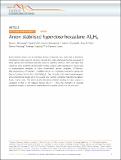Files in this item
Anion stabilised hypercloso-hexaalane Al6H6
Item metadata
| dc.contributor.author | Bonyhady, Simon J. | |
| dc.contributor.author | Collis, David | |
| dc.contributor.author | Holzmann, Nicole | |
| dc.contributor.author | Edwards, Alison J. | |
| dc.contributor.author | Piltz, Ross O. | |
| dc.contributor.author | Frenking, Gernot | |
| dc.contributor.author | Stasch, Andreas | |
| dc.contributor.author | Jones, Cameron | |
| dc.date.accessioned | 2018-08-09T11:30:09Z | |
| dc.date.available | 2018-08-09T11:30:09Z | |
| dc.date.issued | 2018-08-06 | |
| dc.identifier | 254612398 | |
| dc.identifier | cfe6bcc7-06a5-4d11-babb-684b4cb5392e | |
| dc.identifier | 85051272077 | |
| dc.identifier | 000440777000009 | |
| dc.identifier.citation | Bonyhady , S J , Collis , D , Holzmann , N , Edwards , A J , Piltz , R O , Frenking , G , Stasch , A & Jones , C 2018 , ' Anion stabilised hypercloso -hexaalane Al 6 H 6 ' , Nature Communications , vol. 9 , 3079 , pp. 1-6 . https://doi.org/10.1038/s41467-018-05504-x | en |
| dc.identifier.issn | 2041-1723 | |
| dc.identifier.other | ORCID: /0000-0002-7407-8287/work/58055880 | |
| dc.identifier.uri | https://hdl.handle.net/10023/15790 | |
| dc.description | The authors gratefully acknowledge financial support from the Australian Research Council (C.J. and A.S.), the U.S. Air Force Asian Office of Aerospace Research and Development (grant FA2386-18-1-0125 to C.J.), Deutsche Forschungsgemeinschaft (FR 641/25-2) (G.F.), and Director, Bragg Institute, ANSTO, 2011 approval of DB 1959 (A.J.E. and C.J.). | en |
| dc.description.abstract | Boron hydride clusters are an extremely diverse compound class, which are of enormous importance to many areas of chemistry. Despite this, stable aluminium hydride analogues of these species have remained staunchly elusive to synthetic chemists. Here we report that reductions of an amidinato-aluminium(III) hydride complex with magnesium(I) dimers lead to unprecedented examples of stable aluminium(I) hydride complexes, [(ArNacnac)Mg]2[Al6H6(Fiso)2] (ArNacnac = [HC(MeCNAr)2]-, Ar = C6H2Me3-2,4,6 Mes; C6H3Et2-2,6 Dep or C6H3Me2-2,6 Xyl; Fiso = [HC(NDip)2]-, Dip = C6H3Pri2-2,6), which crystallographic and computational studies show to possess near neutral, octahedral hypercloso-hexaalane, Al6H6, cluster cores. The electronically delocalised skeletal bonding in these species is compared to that in the classical borane, [B6H6]2-. Thus, the chemistry of classical polyhedral boranes is extended to stable aluminium hydride clusters for the first time. | |
| dc.format.extent | 6 | |
| dc.format.extent | 945101 | |
| dc.language.iso | eng | |
| dc.relation.ispartof | Nature Communications | en |
| dc.subject | QD Chemistry | en |
| dc.subject | DAS | en |
| dc.subject | BDC | en |
| dc.subject | R2C | en |
| dc.subject.lcc | QD | en |
| dc.title | Anion stabilised hypercloso-hexaalane Al6H6 | en |
| dc.type | Journal article | en |
| dc.contributor.institution | University of St Andrews. School of Chemistry | en |
| dc.identifier.doi | 10.1038/s41467-018-05504-x | |
| dc.description.status | Peer reviewed | en |
This item appears in the following Collection(s)
Items in the St Andrews Research Repository are protected by copyright, with all rights reserved, unless otherwise indicated.

